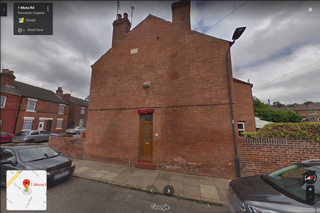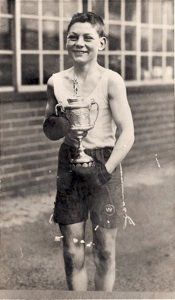
BruceWoodcockBoxer.co.uk
Schoolboy : The Beginning
It began in 1920 in a cramped rented terrace house at 1 Mona Road, Carr Hill, Doncaster (see map/photo). It was an area known locally as ‘The Low Drop’ since the steep incline of Carr Hill was notoriously difficult to climb out of, both physically and socially.
1 Mona Road was home to Sam and Hilda Woodcock and on the 18th of January, Hilda gave birth to the first of four sons, and called him Bruce. Life in the district during that period after the First World War was hard, with low wages and high unemployment. Sam Woodcock was a collier but, given the uncertainty of work, he was often forced to collect the dole, twenty five shillings a week. He also had compensation for the onset of the occupational disease of nystagmus or ‘miner’s eye’, an additional seven shillings and sixpence, which young Bruce collected from the pit, a 12 mile round trip by bike.
Yet Sam was resourceful and inventive, and used his skills as a handyman and rabbit catcher to keep his family going. Hilda was a strong and determined woman, dedicated to her family, and Bruce idolised her.
Sam had been a boxer while in the army and taught his sons a range of sports.
In the year of the General Strike, 1926, life couldn’t have seemed tougher and it was against that background that young Bruce and his father Sam hatched a plan that, unbeknown to them at the time, would eventually ensure the Woodcock family did climb out of ‘The Low Drop’:
Bruce would take up boxing
Schoolboy : Sports in the Blood
Aged merely six, Bruce had already become something of a successful scrapper among his schoolmates, and he heard of a local man, George Slack, wanting to promote two young lads in exhibition fighting bouts at various venues in the area. Under the banner of ‘The Mighty Midgets’, Bruce was teamed up with a friend of his, Mickey Glennon and, boxing each other for three one-minute rounds, they had regular bouts after school for a purse of five or six shillings. Bruce’s weight at the time was 3 st. 6 lb. - a small start for a fledgling heavyweight, fighting in the outlandish attire of socks and a blue swimming costume, too poor to afford boots or vest!
The shows were such a success that George Slack booked the Midgets in towns as distant as King’s Lynn, Peterborough, and Leicester, scene of one of Bruce’s later heavyweight successes. Spurred on by this, Sam stretched the family finances to the limit to buy boxing gloves and a punch ball. He converted the front parlour of the house into a make-shift gym, complete with an old sack filled with sawdust as a punch bag suspended from a well-anchored hook in the ceiling. Soon, Bruce and Mickey’s school mates were regular visitors, forming ‘the Front Room Gang’ as Bruce’s brother Malcolm dubbed them, thirty or so lads, some of whom would go on to their own careers - Malcolm went on to fight under the name ‘Billy Carroll’ as a cruiser-weight. Others included Jacky Cooke, Tacker Roberts, Dunc Hurley, Duggie Myers, Tommy Roughton, Tug Wilson, Jack Skelton and Shacker Hartley.
Schoolboy : First Successes
Along with the boxing and Scouts - he eventually became patrol-leader of the Doncaster 37th troop - Bruce’s Saturdays were taken up working as a barrow-boy on Doncaster market, doing some heavy shifting for three shillings and sixpence a day. His diary records his childish pride in his financial achievements
But his first real success came with his boxing: fighting against Mickey Glennon, his friend and fellow ‘Mighty Midget’ in Peterborough at the age of 12, Bruce won a significant schoolboy contest. Then, he became local schoolboy boxing champion at the weight of 6 st. 7 lb., beating Bobby Fitzpatrick of Armthorpe to win the Hartell Challenge Cup, his first trophy.
This success decided Bruce’s view of his future: he determined he would become a professional boxer with the best of them, alongside heroes such as Americans Jack Dempsey, Gene Tunney, Joe Louis and Wales’s Tommy Farr. His next step was an auspicious sign - Sam put him in for a local Scouts championship at the Scout Hall in Doncaster’s Victoria Street. He was 13 and weighed in at 6st. 4lb. Sam had thought the weight limit 6st. 7lb., but just before the fight he realised it was a stone heavier, and Bruce would be fighting above his weight. This was a pattern that was to recur throughout Bruce’s professional career. Despite the disadvantage, Bruce won, becoming a double champion, Scout and Schoolboy.
Schoolboy : Preparing for the Challenge
A visit from the school inspector ended the careers of ‘the Mighty Midgets’. The limitations of space, along with the discovery by the landlady of plaster coming off the ceiling from the punch bag, put an end to ‘front room’ training and meant Bruce needed to find a new venue. A local farmer, Mr Lazenby, came to the rescue, agreeing to loan out half his barn for a shilling a week. The barn gym and its surroundings would form the basis for a tough and dedicated apprenticeship in the hard world of boxing.
Three Cornered Wood, in the fields at the back of the farm, became the venue for the Front Room Gang’s bare-knuckled challenge bouts, as carefully organised as any professional exhibition. First the challenge was scratched up on the wall of the house on the corner opposite 1 Mona Road; then the contest in the wood, carefully scrutinised by other members of the gang acting as seconds, timekeepers and referees, always with someone on the look-out of the local ‘Bobbies’. The only thing that was up for winning was the pride of success and a sense of emulating the feats they’d read about in schoolboy stories of legendary early prize-fighters from the 18th and 19th centuries, such as William Perry ‘The Tipton Slasher’, or Harry the Coalheaver, or Henry ‘Hen’ Pearce, known as ‘The Game Chicken’. It was boys playing heroes but it was also a serious schooling in an ancient discipline.
That schooling would take another big step soon after, when a local policeman, Jack Woods, a great boxing enthusiast, invited Bruce to train at the gym attached to the Doncaster London and North Eastern Railways (L.N.E.R.) Plant Works, famous for the construction of ‘The Flying Scotsman’ locomotive in 1923. The L.N.E.R. boasted one of the finest amateur boxing teams in Britain and had a first-class gym. In addition to this good fortune, within a short time the Works manager Mr Jones offered Sam a job and Bruce an apprenticeship as a fitter when he left school at 14. It was 1934 and he had everything to fight for.




